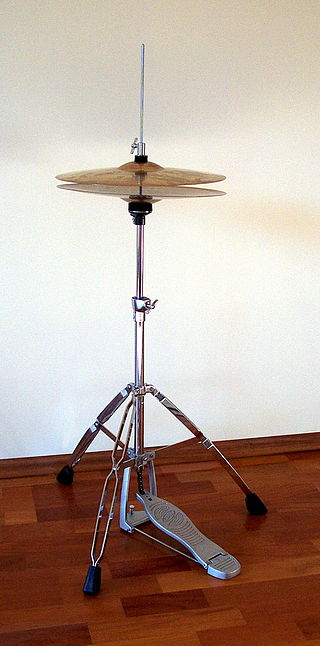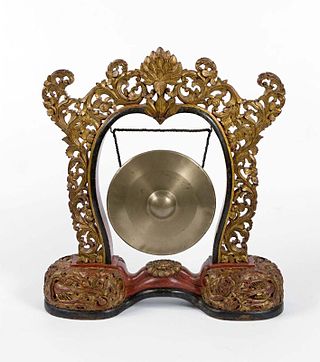Modern cymbal making comprises many different techniques, from traditional hand methods to completely automated mass-production.
Modern cymbal making comprises many different techniques, from traditional hand methods to completely automated mass-production.
Historically, cymbals were made from individually cast cymbal blanks which were then hot-forged, often with many annealing processes, to form the rough shape of the cymbal.
The finishing stages consisted of cold-hammering to unevenly harden the metal, then turning on a lathe to reduce the thickness, and then often a final cold hammering.
The hot and cold hammering were all performed entirely by a highly skilled hand and was a labour-intensive process. The only machine to touch the cymbal was a hand-held lathe.
This lathing step could decrease the weight of the cymbal by two-thirds or more, and resulted in further uneven hardening which produces much of the tone of a traditionally made cymbal. This effect was deliberately enhanced by use of a coarse lathe tool, and sometimes by a very limited final polishing, leaving the lathe tool marks as "tone grooves". Traditional cymbals are lathed over the entire surface top and bottom.
Each stage of this process has been modified by the use of recent technology.
One of the main effects has been that far closer manufacturing tolerances can be achieved, resulting in more consistent sounding cymbals.
This has also provided the opportunity to omit some of the traditional steps completely, and so unlathed, partly lathed, and even unhammered cymbals have entered the catalogs of major makers, and achieved widespread acceptance.
The more unusual of these is rotocasting, in which the mold is spun to force metal into the details of the mold by centrifugal force. This allows the hot forging step to be reduced or even omitted, as the resulting casting can be made far closer to the final shape of the cymbal, including its bell and taper. It is an expensive process used for a few top quality bell bronze cymbals.
Many modern cymbals are stamped or, less commonly, hammered from sheet metal. It is a widely held misconception that only malleable alloys can be cold rolled into sheets. The historical and current production 602 line cymbals and the historical Sound Creation cymbals, both from the major manufacturer Paiste, and the current production M-Series cymbals from Meinl are made from sheet bell bronze with a 20% Tin content. Nevertheless, the term "sheet metal cymbals" tends to refer to cymbals produced from all other common cymbal alloys as opposed to bell bronze.
Some claim that these "sheet" cymbals have a different sound to traditionally made cymbals, owing to their manufacture from sheet metal rather than from individual castings. Others claim that the larger difference is the alloy or the hammering technique. Top quality "cast" cymbals are normally made from bell bronze, while "sheet" cymbals are normally made from malleable alloys.
Paiste even claims that the division into cast and sheet cymbals is misleading, as all alloys are at some stage cast, and refuses to say whether or not particular cymbals are made from sheet metal. Their Sound Alloy patent implies that they have a method for making sheet metal cymbals of this alloy, which would make these a unique third category.
The 2002 Paiste Cymbal Guide even claims that all cymbals are "cast", not just their own, but here they are not using the word in the established sense. All other manufacturers openly state that all of their malleable alloy cymbals are made from sheet metal, and that all of their bell bronze cymbals are individually cast. One possible reason for Paiste's claims is that there is still a great deal of prestige associated with traditionally cast cymbals. The first sheet cymbals were brass, and were very cheaply made. It is only in the last few decades that top-quality sheet cymbals have been produced at all.
But whether this prestige is still deserved is doubtful. The major manufacturer Meinl produces both cast and sheet cymbals, and currently chooses to make their top premium line from sheet bronze. Some top drummers who play Zildjian or Sabian cymbals now choose to play their sheet bronze cymbals, rather than their more expensive cast cymbals, for the sake of their sound.
Louder drummers tend to choose sheet cymbals, while jazz players and major orchestras still tend towards cast cymbals. So it is more a matter of choosing the correct cymbal for the sound required.
Some manufacturers of bell bronze cymbals now use hot-rolling and cold-pressing of individual cymbal blanks rather than traditional forging. These processes are faster and cheaper and appear to have little if any effect on the final sound.
Many manufacturers claim that their cymbals are "hand hammered", but again these words may not always mean the same thing.*

Some hand hammered cymbals are hammered using a hammer held in the cymbal maker's hand. Others are hammered using a proprietary machine, but are still described as "hand hammered" because the hammering is under the control of an individual craftsman.
In general, truly hand hammered cymbals tend to have darker, lower, richer tones, and there tends to be far more variation in character between cymbals of supposedly identical models. Istanbul Mehmet Cymbals are an example of traditionally hand hammered cymbals.
Cymbals hammered by automated machines tend to be brighter, higher in pitch, and more cutting. Most significantly, the variation between supposedly identical cymbals is noticeably reduced, assuming adequate quality control.
The difference in sound is due mostly to the nature of the hammering: hand hammering is done randomly (that is not in a regular pattern) and thus the cymbal has a darker sound-even if this "random" style is dictated and executed by a computer. Symmetrical hammering- which is almost always done by a machine- gives the cymbal a brighter sound. This fact is reinforced by the example of some cymbals from English independent cymbal maker, Matt Nolan, which are unusual in being truly hand hammered but made from Malleable Bronze. The results are darker sounds from what are normally considered brighter alloys.
Paiste has used the same production processes from at least the mid 50's or earlier (they got their first hammering machine in 1952) to the present on all their top of the line Swiss and German produced cymbals.
An electro pneumatic hammer is operated manually by the cymbal-smith, he wears a mount with a spindle on his left knee that holds the cymbal, he uses his thigh to move the cymbal in and out from the hammer to position the blows, with his right foot he controls the power/depth of the hammer blows, with his hands he rotates the cymbal to evenly distribute the hammer marks.
Paiste has been using this technique and the same type of machines since at least the mid 50’s or earlier.
The next step is fine tuning: a different cymbal-smith now hammers the cymbal by hand to fine tune the shape and checks the bow with a ruler and on a steel flat table to make sure the edges are straight, he also checks the cymbal against a “master” for hammer pattern and shape of the bow.
During the 20th century, the mechanical lathe underwent major improvements eventually leading to the automated cymbal lathe

Secondly, the closer tolerances have led to far more use of unturned and partly unturned cymbals. The turning which was once essential to form the shape of the cymbal can now be varied to produce new sounds, especially at the top end of the range.
One pioneering example was the Meinl Raker splash, whose top surface has a single spiral cut by a single pass of a very coarse tool. Another is the Zildjian Earth Ride, whose top surface is not turned at all, but very sparingly hammered. Many manufacturers now produce cymbals with one or both surfaces unturned, or with bands of dark unturned metal. Modern coarse turning patterns allow unturned metal and hammering-marks to show through between the tracks of the lathe tool.
Some lower market cymbals are not turned at all and are produced by pressing rather than turning. The effect on the sound is similar to turning, because the parts of the metal that have been most deformed are most hardened. However the effect that can be produced in this way is very limited.
In the extreme it is even possible to produce a cymbal that appears to have been turned then hammered, by a single operation of a press starting with a flat metal sheet. The result is a round cymbal, with a thickened bell, tapered bow, turning marks and hammering marks.
Away from this extreme, the line between hammering and pressing can blur. Some excellent student cymbals have a final hammering pattern produced by a single blow of a press, after genuine turning. The effect on the metal of this pressing operation is very similar to the effect of machine hammering, and the results are very consistent.
Modern cymbals are available in several polishes or finishes.
Traditional fully lathed cymbals are coated with clear lacquer to protect the bare metal from oxidizing or tarnishing or "browning" from exposure to air and other elements, as well as oil from fingerprints. Because the cymbal retains its shiny look until the lacquer starts wearing off, this finish is still the most common.
The first departure from this was the appearance of "bright" or "brilliant" finishes. These are the result of polishing high speed buffer. Some metal is removed in the process, especially the microscopic ridges in the grooves which produce the high end "zing" sound of a cymbal. The process actually dulls the sound of the cymbals but makes them very visually attractive. These cymbals are usually lacquered as well.
In the case of bands of oxide left on partly lathed cymbals like the Bosphorus Ferrit Antique and Istanbul Custom Sultan it is impossible to decide what the contribution of the oxide pattern is to the sound, as these tend to be complex, top-quality handmade cymbals. But in giving the cymbal designer more options, they allow more precise and focused control, and production of a wide range of sounds.
Finally, on some cymbals the oxide coat is deliberately enhanced to simulate age, or a whole new coating applied. Examples are Meinl Champagne Finish, Masterwork Avanos and Paiste Coloursound. Results depend very much on the actual coating and the cymbal.

A hi-hat is a combination of two cymbals and a pedal, all mounted on a metal stand. It is a part of the standard drum kit used by drummers in many styles of music including rock, pop, jazz, and blues. Hi-hats consist of a matching pair of small to medium-sized cymbals mounted on a stand, with the two cymbals facing each other. The bottom cymbal is fixed and the top is mounted on a rod which moves the top cymbal toward the bottom one when the pedal is depressed.
A crash cymbal is a type of cymbal that produces a loud, sharp "crash" and is used mainly for occasional accents, as opposed to a ride cymbal. It can be mounted on a stand and played with a drum stick, or by hand in pairs. One or two crash cymbals are a standard part of a drum kit. Suspended crash cymbals are also used in bands and orchestras, either played with a drumstick or rolled with a pair of mallets to produce a slower, swelling crash. Sometimes a drummer may hit two different crash cymbals in a kit at the same time to produce a very loud accent, usually in rock music.

A gong is a percussion instrument originating in East Asia and Southeast Asia. A gong is a flat, circular metal disc that is typically struck with a mallet. They can be small or large in size, and tuned or can require tuning.

A blacksmith is a metalsmith who creates objects primarily from wrought iron or steel, but sometimes from other metals, by forging the metal, using tools to hammer, bend, and cut. Blacksmiths produce objects such as gates, grilles, railings, light fixtures, furniture, sculpture, tools, agricultural implements, decorative and religious items, cooking utensils, and weapons. There was an historical distinction between the heavy work of the blacksmith and the more delicate operation of a whitesmith, who usually worked in gold, silver, pewter, or the finishing steps of fine steel. The place where a blacksmith works is called variously a smithy, a forge or a blacksmith's shop.

Sabian is a Canadian cymbal manufacturing company established in 1981 in Meductic, New Brunswick, where it is still headquartered. Sabian is considered one of the big four manufacturers of cymbals, along with Zildjian, Meinl and Paiste.
Cymbals are made from four main alloys, all of them copper-based. These are: bell bronze, malleable bronze, brass, and nickel silver.

Metalworking is the process of shaping and reshaping metals to create useful objects, parts, assemblies, and large scale structures. As a term it covers a wide and diverse range of processes, skills, and tools for producing objects on every scale: from huge ships, buildings, and bridges down to precise engine parts and delicate jewelry.

Repoussé or repoussage ( ) is a metalworking technique in which a malleable metal is shaped by hammering from the reverse side to create a design in low relief. Chasing or embossing is a similar technique in which the piece is hammered on the front side, sinking the metal. The two techniques are often used in conjunction.

In western music, a China cymbal is a distinct type of crash cymbal designed to produce a bright, crisp, and explosive tone that has brought it the nickname trash cymbal. The name "China cymbal" comes from its shape, which is similar to that of the Chinese Bo. Such cymbals are most frequently mounted upside down on cymbal stands, allowing for them to be more easily struck and for a better sound.
In a drum kit, splash cymbals are the smallest accent cymbals. Splash cymbals and china cymbals are the main types of effects cymbals.

The swish cymbal and the pang cymbal are exotic ride cymbals originally developed and named as part of the collaboration between Gene Krupa and the Avedis Zildjian Company. The current Zildjian Swish Knocker is a redesign of their original swish, with more rivets, deeper bow and shallower bell, based on a cymbal made famous by Mel Lewis, who coined the name knocker.

Bell metal or bell bronze is an alloy used for making bells and related instruments, such as cymbals. It is a form of bronze with a higher tin content than most other bronzes, usually in approximately a 4:1 ratio of copper to tin. The higher tin content increases the rigidity of the metal, and increases the resonance. Historically, it was preferred for early cannons. Today, it also has industrial uses, being specified for valve bodies, piston rings, bearings, and bushings.

Paiste is a Swiss musical instrument manufacturing company. It is the world's third largest manufacturer of cymbals, gongs, and metal percussion. Paiste is a Finnish and Estonian word that means "shine".

UFIP, an acronym for Unione Fabbricanti Italiani Piatti is an Italian musical instrument manufacturing company based in Pistoia, Tuscany.

Zanchi is an Italian brand of cymbals. The brand was made between 1947 till around the mid 1990s, and was noted for its 'Vibra' cymbals.

Meinl Percussion is a manufacturer of percussion instruments based in Gutenstetten, Germany. The company’s cymbal production is one of the "big four" manufacturers of cymbals, along with Zildjian, Sabian, and Paiste.
Bellfounding is the casting and tuning of large bronze bells in a foundry for use such as in churches, clock towers and public buildings, either to signify the time or an event, or as a musical carillon or chime. Large bells are made by casting bell metal in moulds designed for their intended musical pitches. Further fine tuning is then performed using a lathe to shave metal from the bell to produce a distinctive bell tone by sounding the correct musical harmonics.
A flat ride cymbal or flat top ride is a ride cymbal without a bell, originally developed by Paiste in collaboration with jazz drummer Joe Morello as part of their Formula 602 series in 1967. The most common size is 20" followed by 18", but larger examples exist: Paiste Formula 602 flatride

Agean Cymbals is a manufacturer of cymbals and other percussion instruments of the Western Classical, Folk, and Turkish traditions. Their factory is located in Edirne, while its main office is situated in Istanbul. They state a commitment to preserving hand-crafted techniques and a tradition of cymbal making that dates back to the Ottoman Empire, as part of their manufacturing ethos.